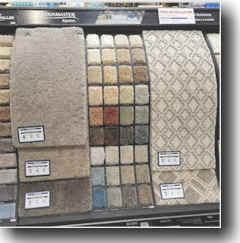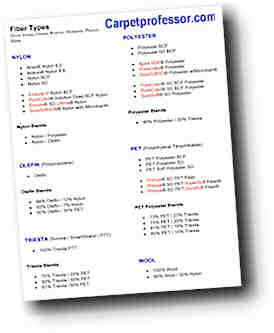How To Choose New Flooring Like A Pro!
Top 500 Best Local Carpet Stores
(Free Information by Consumer Advocate - No Flooring Sales)
Understanding Carpet Specifications
The Key To Choosing New Carpet Wisely!
Why Do Homeowners Need Carpet Specifications?
 New
carpet is a major homeowner expense and many homeowners choose the wrong grade of
carpet and end up making a very costly mistake.
New
carpet is a major homeowner expense and many homeowners choose the wrong grade of
carpet and end up making a very costly mistake.
If you want to make a wise carpet selection and be sure to get your full monies worth, you need to know what carpet grade or quality level of carpet you need to buy for your home.
Understanding Carpet Specifications is the ONLY sure-fire way for you to know if the carpet you select is able to tolerate the level of foot traffic you have in your home. This also reveals how long it will last and retain its like-new appearance.
Choose the wrong grade of carpet and it WILL certainly wear out faster than you anticipate and you will not be happy with the outcome. Take my free Carpet Foot-Traffic Test to see where you stand.
Obtaining Carpet Specifications
Sometimes finding all the carpet specifications you need to help you make wise and informed carpet-buying choices can be difficult, if not seemingly impossible, depending on where you shop for carpet. Some carpet retailers are reluctant to freely provide carpet specifications to their customers. I don't recommend buying from dealers who refuse to provide specifications to homeowners.
3 Ways Dealers Can Get Carpet Specifications
1. Dealers can call the Carpet Manufacturer directly – most carpet mills are happy to fax or email the carpet " spec sheet". You can also call the carpet manufacturer yourself as long as you have all the key information about the carpet in question. The manufacturer; the style name; the color name; or color number.
2. Dealers can login to their online carpet mill account - to gain access to carpet specifications. This may require a store manager to login to obtain the information you want. It is easy for them to do, if they are willing to take the time to do it.
3. Dealers can call their Carpet Mill Representative to obtain the information you need. Every carpet retailer has the cell phone number to reach their carpet account representative. It may take a day or two for their mill rep to provide the carpet specs you want, but they can provide it if they are willing to take the time. If they don't, then I suggest you buy from another dealer who will!
Call the Carpet Manufacturer Yourself!
You can always call and ask for the carpet specifications directly from the manufacturer as long as you have the manufacturer's brand name and the carpet style name. Here is my List of Carpet Mill Websites and their phone numbers.
How to Figure Out Carpet Specs Yourself.
When it comes to Pile Height, Pile Density and Face-Weight... this might not be a big problem if you can find or even closely guesstimate two out of three carpet specs, then you can easily figure out the third specification...Using simple mathematics!
Below I explain in detail what you need to do, and how you can quickly and easily figure out all the carpet specifications you need to acquire, even if the dealers refuse to give you hardly any information at all!
The 5 Main Carpet Specifications:
1. Pile Height
The Pile Height measurement is not usually shown on the carpet sample, however all you need is a tape measure. Don't include the carpet backing, just the soft fibers from the backing up. Convert the measurement into a decimal for calculating purposes. Example= One half inch (1/2") is equal to (.5) decimal. See chart below
Decimal to Fractions Conversion
0.0625 = 1/16
0.125 = 1/8
0.1875 = 3/16
0.250 = 1/4
0.3125 = 5/16
0.375 = 3/8
0.4375 = 7/16
0.5 = 1/2"
0.5625 = 9/16
0.625 = 5/8
0.6875 = 11/16
0.750 = 3/4
0.8125 = 13/16
0.875 = 7/81.0000 = 1"
1.0625 = 1- 1/16
1.125 = 1- 1/8
Benefits from Reduced Pile-Height
Many people want to enjoy the luxurious appearance and soft texture of a deep, thick carpet. However, this opulence may not be suitable for every room in your home. In areas where there is moderate to heavy foot-traffic, it may be advantageous to consider adjusting the carpet characteristics for optimum results.
Many plush carpets have a pile-height of 1 inch or more. By reducing the pile-height to 3/4" or less, you can enhance the carpet's durability and resilience. A shorter pile-height helps prevent matting and crushing of the pile, and makes it easier to vacuum. If the carpet face-weight remains unchanged, reducing the pile-height will automatically increase the pile-density which contributes to improved durability, increased lifespan, and makes the carpet easier to clean.
While using this "insider secret" can significantly boost carpet durability, it does involve a trade-off, and that involves sacrificing a degree of that opulent plush look and feel. This is a strategy worth considering for the primary "heavy traffic" areas of your home, while still maintaining the deep, soft, and luxurious feel in your bedrooms.
Carpets designed for commercial use always have a shorter pile height and increased pile density. This is what enables them to withstand years of heavy foot-traffic. These two carpet specifications are the key to success in high-traffic environments such as offices, churches, retirement homes and airports. It can also be the reason for success in your home too.
2. Pile Density
Pile Density is a mathematical calculation based on fiber Face-Weight and Pile Height. Think of a heavily wooded forest. The more closely packed together the trees are, the more dense the forest is.
The same goes for carpet. You want a carpet with the tufts packed tightly together. This helps the carpet resist matting and crushing of the pile and increases longevity. Pile Density is the most important factor next to Fiber Type.
3. Face-Weight
Face-weight is the actual weight of the fiber used to manufacture the carpet pile, but does not include the weight of the carpet backing. Fiber Face-weight is not the same as Total Carpet Weight, which includes the weight of the carpet backing and the fiber face-weight.
Most carpets have a face-weight somewhere between 20 ounces and 100 ounces, but the average face-weight for a residential carpet is about 35 to 60 ounces. A higher face-weight does not automatically mean the carpet is a better grade; is a higher quality; is more durable; or is more costly.
Fortunately, these three carpet specs are mathematically related which is good news for you. If you can figure out one, or two out of the three specs, then you can easily figure out all the other specifications using the formulas I reveal below!
How To Calculate Carpet Specs Yourself?
Carpet Specification Rules
Carpet Rule
# 1:
Let's assume you don't know what the Pile Density rating is of a carpet you are interested in buying, but you do know the Face-Weight and Pile Height.
Face-weight is a number between 1 and 100.
Pile Height is a Fraction turned into a decimal (like .75 for 3/4").
(see Decimal to Inches (fraction) Conversion Table above)
Formula: Face-Weight x 36 ÷ Pile Height = Pile Density
(e.g.) (30 X 36 ÷ 0.50 = 2160)In this example, what we know is that the face weight is 30 ounces and the pile height is 0.5 (one half inch).
We can now use Rule #1 to determine the Pile Density Rating.
Carpet Rule
# 2:
Let's assume you don't know what the Face-Weight rating is of a carpet you are interested in buying, but you do know the Pile Height and Pile Density.
Formula: Density x Pile Height ÷ 36 = Face Weight
(e.g.) (2160 X 0.50 ÷ 36 = 30)In this example, what we know is that the Pile Density is 2160 and the pile height is 0.5 (one half inch).
We can now use Rule #2 to determine the Face-Weight in ounces.
Carpet
Rule
# 3:
Let's assume you don't know what the Pile Height is of a carpet you are interested in buying, but you do know the Face-Weight and the Pile Density.
Formula: 36 ÷ Density x Face-weight = Pile Height
(e.g.) (36 ÷ 2160 X 30 = 0.499998 (0.5))
In this example, what we know is that the Pile Density is 2160 and the Face Weight is 30 ounces.We can now use Rule #3 to determine the Pile Height in decimals, which can quickly be converted into a fraction of an inch using the chart above.
Carpet Rule # 4:
Let's assume you don't know the Tuft-Twist rating of a carpet you are interested in buying.
4. Tuft Twist Rating
Carpet fibers, also called yarn, is either extruded or twisted to form a single strand or "filament". These filaments are similar in size to a human hair. A bunch of filaments are grouped together and twisted together to form Tufts.
While these strands are twisted, heat is applied to "set" them permanently, hence the term "heat set" or "perm". This is very similar to the way women might use a curling iron to create and set curls into their hairstyles.
The tighter the tufts are twisted together the longer the carpet is able to maintain its "like-new" appearance.
It is not difficult to guesstimate the number of Tuft-Twists of a carpet you are considering. Tuft-Twist is really quite simple. When you look at a carpet you can look closely at the tuft and easily count the number of twists yourself. You just need to remember that it is based on the number of twists per lineal inch of tuft.
Below are Tufts that are one-inch long. I have used two colors to show the number of twists.
The Tuft Twist Rating is based on the number of twists per lineal inch of tuft.
This Tuft has 7 twists and is a sign of a well-made carpet. Frieze styles have tufts similar to this and cost about $30 per square yard on average, or $3.33 per square foot.
This Tuft has 4 twists and is not as good. This is a sign of a lower-grade carpet. Inexpensive Plush and Textured Plush styles often have tufts similar to this and range from $10 to $20 per square yard or $1.11 to $2.22 per square foot. More expensive styles have higher Tuft-Twist ratings.
Why is Tuft Twist Important?
The Number of Tuft Twists is an important key to making sure your carpet retains its like new appearance longer. Frieze styles tend to have a higher tuft twist (over 6 per lineal inch) and is why they are well-known for their durability and retaining a like-new appearance longer than many other styles.
When you look at a potential carpet to buy you can look at the tuft and count the twists yourself. Looped Berber carpets have twisted tufts too, but it is very hard to count them with the naked eye. Most looped Berber styles will state the tuft twist rating on the sample or the manufacturer's spec sheet.
A few important Carpet facts no one else will tell you...
If you want your carpet to last longer, I recommend a Carpet Pile Height of less the 3/4". On stairs, I recommend a Carpet Pile Height of 1/2" or less and a Carpet Padding thickness of 7/16" or less and a Pile Density Rating of at least 8-pounds. 10 pound pad density would be better. Learn more about Carpet Padding
Carpets with a lower Tuft Twist Rating (of 3 to 5), tend to untwist or “blossom” at the tuft tips more quickly, thus creating a worn out, frizzy looking or matted down appearance. Carpets seldom wear out from the loss of fiber, they just start to mat down; gradually lose the luster and shine; and start looking bad. Once the tufts have blossomed and become matted down, it cannot be reversed or repaired.
Carpet Facts to Remember:
-
The Tuft Twist Rating is based on the number of twists per lineal inch of the tuft. A tuft that is only a half inch long you would need to double the twist count to figure out what the twist rating is.
-
Still, it's fairly easy to guess the number of twists with the naked eye. Compare with other known-specs carpet samples and view side by side.
-
The Tuft Twist count usually range from 3.0 to 7.5. Lesser quality carpets will have a lower number of Tuft Twists.
-
The higher the Tuft Twist the longer your new carpet will retain its like-new appearance.
-
Carpet "Blossom" or blooming is a common carpet condition where the Tuft begins to un-twist and starts to look worn out, matted down and ugly!
Some carpets with a lower Tuft Twist rating try to compensate with a higher Pile Density. Manufacturers of Polyester and PET Polyester carpets often use this strategy to increase durability and reduce matting and crushing of the pile.
P.E.T and Polyester are very soft fibers however they are not very resilient. This means they are inherently prone to matting down and crushing of the pile, especially in medium to heavy traffic applications.
Carpet made from PET Polyester and Polyester fibers cost less than Nylon, but if you want your carpet to last a long time and you have medium to heavy foot traffic, then I suggest you choose a carpet made of nylon.
I would also discourage you from buying PTT, Triexta, Sorona, aka Mohawk Smartstrand if you have a Moderate to heavy traffic application. P.E.T. is an abbreviation that has nothing to do with your pets, it stands for Polyethylene Terephthalate, a plastic commonly used to manufacture plastic water or pop bottles.
Nylon is the most durable and most resilient fiber used to make carpet, second to none. It is more costly to manufacture and it is not as soft as a P.E.T or Polyester or the Smartstrand (aka PTT or Triexta) fiber. However Nylon will typically last years longer if properly cared for and will resist matting and crushing of the pile better than any other fiber.
New Carpet Warranties
It's an eye opening experience to read a New Carpet Warranty. There are many limitations and exclusions. It's easy to see that they try to make it very difficult to substantiate a valid claim.
You must follow the manufacturers care and maintenance requirements to the letter or risk voiding the warranty altogether. Don't buy carpet based solely on the warranty limits, consider all the specifications.
5. Carpet Fibers
 There
are many different fibers to choose from. These are the most common.
There
are many different fibers to choose from. These are the most common.
-
Nylon
-
Triexta (Sorona / PTT)
-
Polyester / PET
The fiber you select will determine how long your carpet will last and how well it will resist stains. My Fiber Chart shows various fibers and fiber blends available today.
(click on the image to view or print)
Learn more:





